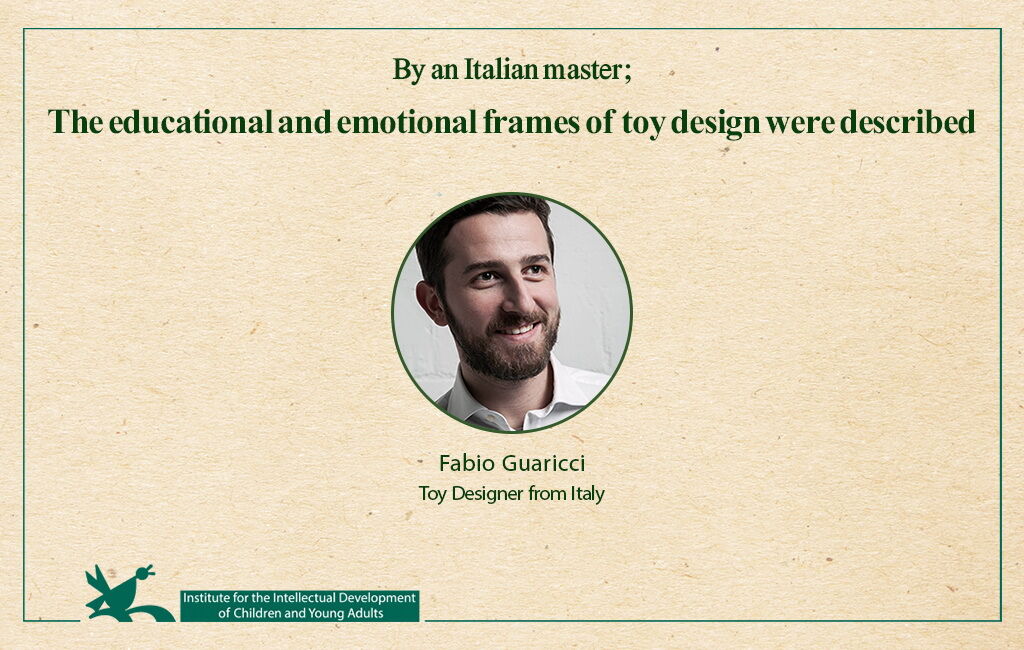According to Kanoon General Directorate for Public Relations and International Affairs, Fabio Guaricci, a visiting professor at the Polytechnic University of Milan and a toy designer, shared his more than 15 years of scientific and professional experience with some toy designers and idea makers in Iran in an online specialized meeting.
Guaricci spoke at a meeting on Saturday, May 1, 2021, organized by the General Directorate of Constructive Entertainment and Computer Games of Institute for the Intellectual Development of Children and Young Adults (Kanoon), and the Secretariat of the National Toy IdeaAzad Event, about the importance of educational and emotional frameworks in toy design, as well as six important steps in licensing an idea.
The Italian designer started his professional activities in the field of toy design 15 years ago with his academic dissertation on wooden toys and has been working as a designer or consultant with large toy manufacturing companies in Italy and Europe. He is currently founding his academy, advising and mentoring young designers and ideators.
Fabio Guaricci spoke about different perspectives on design, comparing the two best-selling products in the European and American markets. The Italian designer went on to analyze the causes of success and important points from the idea generation process to the production of these two products. This analysis was performed using 6 stages of idea licensing, which was invented by Mr. Guaricci himself.
In these six steps, Guaricci first pointed out the importance of the idea being attractive and new and said that the idea that the designer creates must be attractive to the producers to persuade them to invest in it. He then emphasized product valuation and suggested that designers should always study the market, develop the values of their design and idea, and present a design to the appropriate manufacturer.
The Italian designer also stressed the time required for these steps and said: "Designers shouldn't rush through these steps and spend more time on the basic issues of their design." Supporting and protecting the idea was another important point that he believes designers and ideators should pay attention to because, in an industry that is always growing and changing rapidly, it is the designers' job to defend their design and to protect it and submit it to the right people related to your idea or design.
Guaricci said the last step was to sign a cooperation agreement with companies and manufacturers and said that designers should act professionally at this stage and can use the advice of professionals to achieve their goals.
Fabio Guaricci mentioned the importance of contracting between designers and manufacturers, saying that "inexperienced people usually sell all the benefits of their design to manufacturers, but a designer who uses expert advice works with companies as a partner and owner of the design."
He also pointed out the importance of using the suggestions of experts and manufacturers and said: "People in the market are very experienced and know the market better than designers. In many cases, having flexibility and using the suggestions of these experts will benefit the designer."
Guaricci continued his speech by focusing on educational and emotional frameworks. In an educational context, he categorized issues into two dimensions: social and cognitive. Fabio categorized symbolic games, construction games, and legal games in the cognitive dimension, and individual, parallel, participatory, and collaborative games in the social dimension of the toy design framework. And described: In addition to limiting the scope of the product, these frameworks also reflect the values of that product.
Guaricci went on to explain the emotional framework and listed four important bases. Building a master or a skilled person, building a creative person, building a support person, and building a simulator are the four main pillars in emotional frameworks. He then gave examples of the world of entertainment and toys for each of these pillars, explaining how a product can affect children's feelings and emotions and play an important role in their future lives.
At the end of the meeting, Italian designer, Fabio Guaricci, in addition to answering the questions of the participants, stressed the importance of creativity of the ideators and designers and said that designers should not be afraid of the big toy industry and market, but should go with it and gain experience.
He also answered one of the participants that asked: "Should the whole design process be done alone or not?" He replied that design work and especially toy design is a group activity because if the designer wants to work alone, he loses a lot of time and cannot be successful in industry and market.
In this meeting, which was held on Saturday, May 1, 2021, with the presence of some toy designers and ideators from different cities of the country, Aidin Mehdi-Zadeh, secretary of the 4th National IdeaAzad Toy event of Institute for the Intellectual Development of Children and Young Adults (Kanoon), announced the continuation of these meetings with foreign guests.

